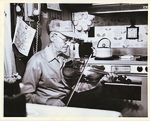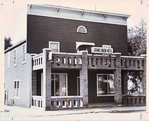In the days before commercial recordings and electronic media, songs were sung for entertainment around the house, on the job, and in public community settings. A talented singer possessing a repertoire of songs was held in high regard for ability to be “the television of the day.” Ancient British Isles ballads of love and war were sung alongside comic songs, broadsides, songs of historical events, religious/sacred songs and newer creations about local events.
Far
from being the staged event it so often is today, singing in earlier America
was something ordinary people did to pass time, to help the work go more
quickly, to comment on a recent event, to provide a bit of humor, or to
entertain self, family, friends and/or co-workers after the day’s work was
done.
The
style of singing was quite straightforward generally, with little or no
ornamentation and a strong emphasis on the song itself and the story that it
told. The singer took a backseat to the
song.
“Rachel
(a second cousin) was in the kitchen and she was working around and she
was
singing....and she was adding all little grace notes and going up and
going down
and, gee, I thought that sounded good.
So, when I went home a day or two later I’m out in the kitchen doing
the
dishes at the sink, and I’m singing Mom’s ‘Nobleman’s Wedding’ and I
decided
that would sound pretty good with all those little ‘doo dads’ in it, so
I’m
giving it everything I can find to put in it.
About that time Mom comes to the dining room door and she looks out at
me and said ‘Who did you hear singing like that?’...(I told her it was
Rachel)...she said, well, maybe her songs sound alright like that but
mine
don’t, and if you’re gonna sing my songs you sing them the way they
belong
or you shut your mouth. Needless to say, I shut my mouth.”
-- Sara Cleveland, Ballad Singer, Brant Lake
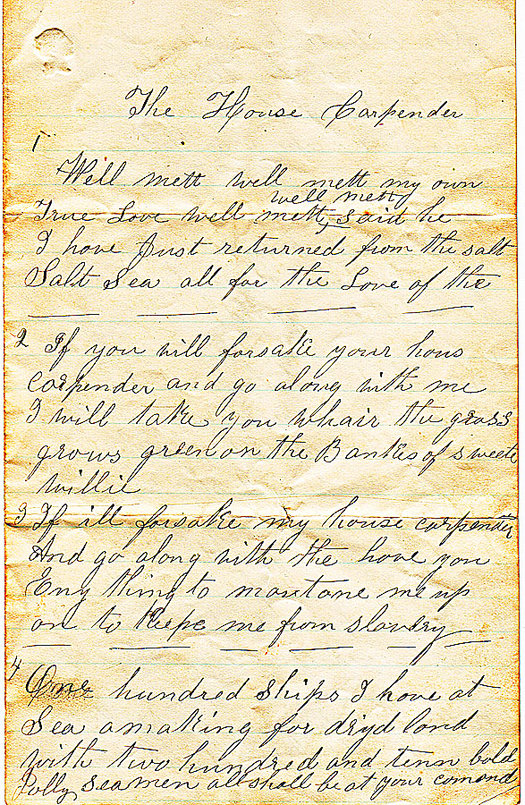 Not
everyone sang, certainly, and only some were thought of as “good singers,” but
that label often had more to do with the quantity and quality of songs the
singer knew, and less to do with vocal quality.
Accolades for older singers so often contain some variation of the
phrase “boy, I’ll tell you, he could sing all night and never sing the same
song twice.”
Not
everyone sang, certainly, and only some were thought of as “good singers,” but
that label often had more to do with the quantity and quality of songs the
singer knew, and less to do with vocal quality.
Accolades for older singers so often contain some variation of the
phrase “boy, I’ll tell you, he could sing all night and never sing the same
song twice.”
The general repertoire of oral tradition songs in the Adirondacks numbered in the thousands, with some pieces found more frequently than others. It was not uncommon for traditional singers to have 100 or more full songs in their memories at any given time, with a few singers (that we know about) possessing repertoires of over 200 songs.
Typically, no two singers outside of an immediate family--and sometimes within one--would have identical versions of the same song (there being exceptions, of course). Because of the nature of the oral tradition, the changes one makes to a given song during and after the time it is committed to memory, conscious or not, result in infinite variations on both lyrics (text) and melody (tune).
Barrooms,
lumber camp bunkhouses, front porches, parlors, work bees (quilting, husking,
barn raising, etc), fireplaces, kitchens and general stores would each provide
an atmosphere and context ripe for the singing and sharing of these tales set to music.
Lumbercamp Singing
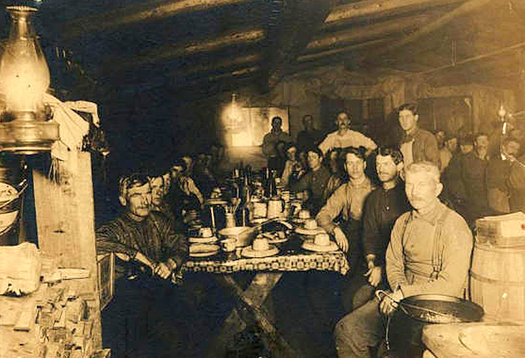 By
the mid nineteenth century, New York State had surpassed Maine as the
preeminent lumbering state in
America. With the main logging season
occurring in the fall, winter and early spring months, lumbermen and camp cooks
would trek miles into the woods in October or so, often not to see the outside
world again until April, or later.
Working six days a week for twelve to fourteen hours a day in the wintry
woods left precious little time or energy for recreation, although to say that
entertainment was prized in these off hours would be an understatement. We have many
accounts of lumber camp employment bolstered by one’s ability either to
sing a song, tell a story, fiddle a tune or dance a dance.
By
the mid nineteenth century, New York State had surpassed Maine as the
preeminent lumbering state in
America. With the main logging season
occurring in the fall, winter and early spring months, lumbermen and camp cooks
would trek miles into the woods in October or so, often not to see the outside
world again until April, or later.
Working six days a week for twelve to fourteen hours a day in the wintry
woods left precious little time or energy for recreation, although to say that
entertainment was prized in these off hours would be an understatement. We have many
accounts of lumber camp employment bolstered by one’s ability either to
sing a song, tell a story, fiddle a tune or dance a dance.
“An
interesting story is told
concerning (Theodorus Older’s) arrival in Keene Valley, where he
settled about 1870. At dusk of a winter day a powerfully built
stranger stopped into Crawford’s Store
and, without saying a word to anyone, walked
to the stove and began to warm himself.
After a few minutes, with his back
to the stove, he began softly singing to himself. In short order more
people were entering than leaving the store and
those who had business to transact did so
in lowered voices. The tall stranger
remained singing until 10 or 11 o’clock at night
when he finally spoke to ask: ‘Any work
around here? I’m a chopper.’ A job
was quickly found for him in the area.”
-- Peter McElligott,
referring to singer/fiddler Lawrence Older’s grandfather
Occasionally
on weekday evenings, and most often on Saturday nights (with Sunday being
the traditional day off), singing
lumbermen in camp would take their turn on the “deacon seat” in the bunkhouse,
offering songs old and new in an unaccompanied (“a capella”) declamatory style
for the entertainment of themselves and their co-workers. The songs in a typical Adirondack lumberman’s
repertoire contained a mix of logging and non-woods themes, and with the
variety of men one worked with from camp to camp and year to year, there were
endless opportunities to pick up new songs.
Some
of the more commonly found songs in the Adirondack lumbercamp repertoire, circa
1880-1930, are: “The Wild Colonial Boy,”
“The Wild Mustard River” (aka “Johnny Stiles”), “The Ballad of Blue Mountain
Lake,” “The Farmer’s Curst Wife,” “The Darby Ram,” “Barbara Allen,” “The Days
of ‘49,” “The Little Mohea,” “The Flying Cloud,” “Johnny Sands,” “The Lass of Glenshee,” “The St
Albans Murder,” “The Cumberland and the Merrimac,” “Once More A-Lumbering Go,”
“The Shanty Boy,” “The Farmer Boy,” “James Bird,” “The Woodsman’s Alphabet,”
“The Flat River Girl” (aka “Jack Haggerty”), “The Backwoodsman” (aka “One
Monday Morning,” “The Dance at Clintonville”), “Joe Bowers,” “Lord Lovell,”
“Kate and Her Horns,” “John Riley,” “The Banks of the Sweet Dundee,” “Lord Randall,”
“Cole Younger,” “A Shantyman’s Life”, and perhaps the most ubiquitous of all…“The Jam on
Gerry’s Rock .”
“I probably sung that thing maybe 5,000 times…That was the big one for a majority of the fellas. ‘Course, it was a lumberjack song, you might say...”
-- Ted
Ashlaw, referring to “The Jam on Gerry’s Rock”
-- Lawrence Older, referring to “The Jam on Gerry’s Rock”
“Those deaths occurred in so many
areas…in fact, I’ve heard that name changed to
an area death...because it matched so
perfectly the happening that they knew of,
they used a different
name. When I married my first
husband…his mother sent me all the words, and they were a little bit
different (from the version sung by my grandmother).”
-- Ermina Pincombe, referring to “The Jam on Gerry’s Rock”
The importance of lumber camp singing and song repertoire cannot be overemphasized in any look at Traditional Adirondack Music. Singing lumbermen highlighted on this website include “Yankee John” Galusha, Ted Ashlaw, Eddie Ashlaw, Steve Wadsworth and Lawrence Older, although we see the influence of the woodsman’s repertoire for numerous other Adirondack singers.
Barroom Singing
Often an extension of lumber camp singing, barroom or tavern performance was an art form all its own in Adirondack towns and outposts of old. The barroom, if we are to believe old stories told by woodsmen and others, was the first place many loggers would steer in the springtime, or on weekends, once they had a little change in their pockets. A singer with a decent repertoire of songs, once discovered and called upon, would sing song after song to the delight of the other patrons, and would be treated with special status for the remainder of their stay at the tavern.
“Draft beer was ten cents. You could go in there with one little dime in the afternoon, and you’d come out that night walking sideways.”
-- Dick
Law, Traditional Singer, Hermon
On
a lucky night, one might encounter several singers of the old-time songs
congregated at a woodsmen’s tavern.
“… Tupper Lake was always pretty
good for singing. You’d get in there, and the group
would be singin'-- five or six of us, sometimes more. (At the Grand Union Hotel) there was a big bunch would come that were all
good singers. We’d get in a huddle at the end of the bar, and we’d whoop her up there.
Tupper Lake is shot now...you
start singing in a bar and they turn the
jukebox on.”
-- Eddie Ashlaw, Traditional Singer, Parishville Center
The
tavern setting, like the lumbercamps, also gave singers the opportunity to
“pick up new pieces,” to hear major change versions and minor change variants
in texts and tunes of their own songs , and to experience other styles of
singing in a relaxed, informal setting.
Home Singing
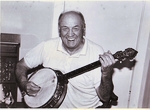
Some
of our most important and well-known Adirondack singers, including Sara
Cleveland and Lawrence Older, mention hearing and learning their first songs at
home from members of their family. In
the home setting, singing ranged from a solitary activity while washing dishes
or tending gardens to a group activity with family members gathered around on a
winter’s night. If the “family around
the hearth” image sounds a bit romantic, this is how Sara Cleveland described
it:
-- Sara
Cleveland, Ballad Singer, Brant Lake
Singing
around the house was a natural part of life in many homes, and Adirondack
singers and musicians have often mentioned that “you didn’t think anything of
it at the time.” The songs would become
part of the rhythm of home life, and without much effort at all, some of them
would end up in the next generation’s repertoire. Other more lengthy songs would be carefully gone over time and
time again until the new singer had “gotten it all together." Songs learned from
family members in this way tended to stick with the singers, and would bring
back special feelings when sung.
Community
Singing
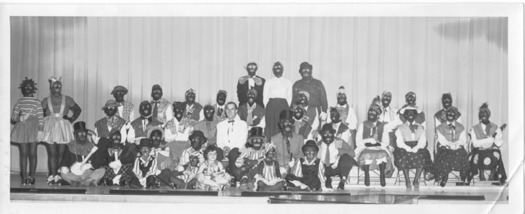
Outside of the tavern/barroom setting mentioned above, there were several other important public places within Adirondack communities where singing would take place. These include work bees, family gatherings, Grange meetings, talent shows, local school events, minstrel shows and more.
“You’d take around Christmas time. Why, you don’t see it no more, but we’d be three weeks (visiting) from one house to the other. Team on a set of sleighs. And probably fifteen or twenty people on it. We’d go from one relative to the other...and you’d always find about ten up singing all the time, ten drunk. There was once in awhile a fiddler, but that’s about all. Singing in French and English. And… there was a lot of songs...and they’d go to the week after New Years. They called that ‘little NewYears’...Well, that’s the way they spent Christmas years ago.”
-- Eddie Ashlaw, Traditional Singer, Parishville Center



